Yosemite National Park
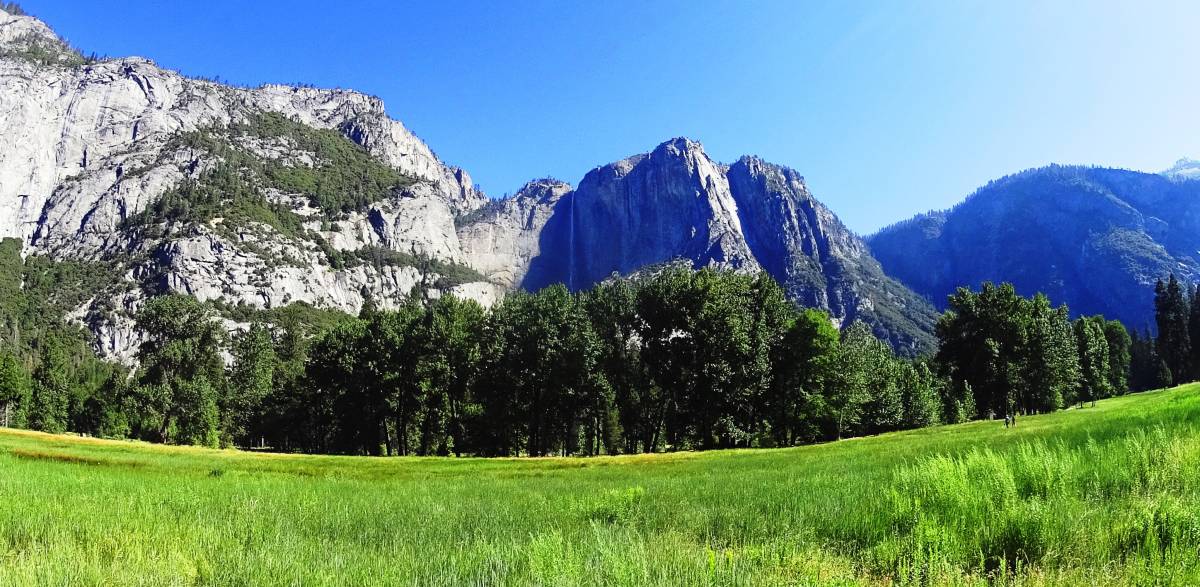 Location: California/USA/Sierra Nevada Mountain Range
Location: California/USA/Sierra Nevada Mountain Range
Elevation: 3,500ft to 14,500ft
Prominence: 5000ft
Note: There are plenty of instances in history where people ascribed personas to mountains and landscapes. There are even instances where saints and sages believed that God literally resided within certain mountains, like at Mount Arunachula in southern India. This seems like the best way to introduce the experience of The Half Dome at Yosemite National Park. The best words to describe Yosemite have already come from an American sage, who also saw God in the mountains here. When gazing upon Yosemite for the first time, you can absolutely understand why. Although American naturalist John Muir was originally from Scotland, a place where the Highland Mountains blast out of the landscape with a most massive rugged intensity (Image/Left)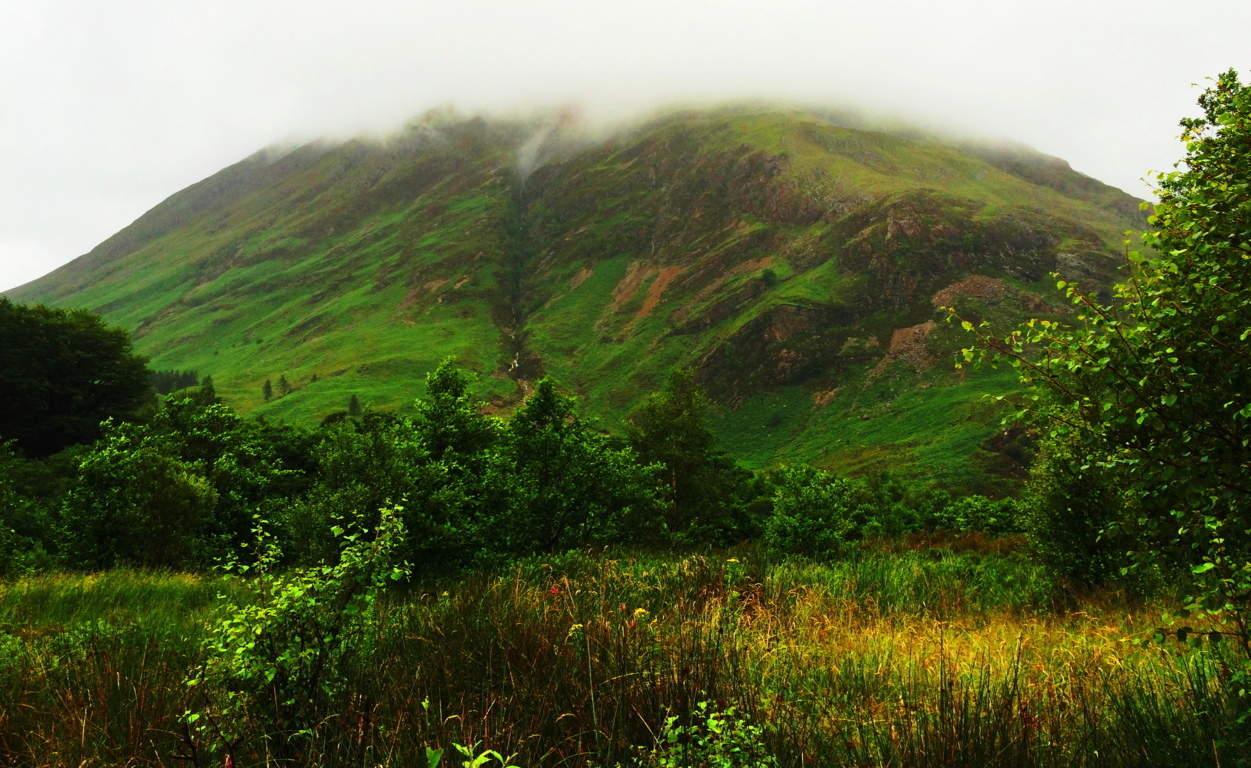 it would actually be at Yosemite, many years after migrating to America, that the mountain-made anointing would find him, filling him with the inspiration to ascribe this place the most sacred Range on Earth. This is the Sierra Nevada’s of California. About the Half-Dome Mountain heights John Muir would write: “…it seems full of thought, clothed with living light, no sense of dead stone about it, all spiritualized, neither heavy looking, nor light, steadfast in serene strength, like a god.” (image/below)
it would actually be at Yosemite, many years after migrating to America, that the mountain-made anointing would find him, filling him with the inspiration to ascribe this place the most sacred Range on Earth. This is the Sierra Nevada’s of California. About the Half-Dome Mountain heights John Muir would write: “…it seems full of thought, clothed with living light, no sense of dead stone about it, all spiritualized, neither heavy looking, nor light, steadfast in serene strength, like a god.” (image/below) 
This type of language, written about the Half Dome in this excerpt, would eventually lead the American populace to christen John Muir as a Prophet of the North American West, like a Moses of American mountain chains. Muir became a disciple of the landscape, almost a child in spirit, as he recognized the context of his life against this vast wilderness. And although John Muir truly is an example of what really can happen to us out there in the heights, or in the thick of the forests, it is important to realize (for at-least a moment) that there was an entire nation of Native Americans who were already disciples of the land. Natives were simply being destroyed, even as John Muir was announcing his ‘good news’ to readers back east. This was ‘good news’, of course, that the indigenous Ahwahnechee (Ah-wen-nahk-ee) Native American Tribe had not only understood, but utterly embodied, for God-knows how many thousands of years, at what would become Yosemite National Park. And who could blame them? Look at this place! Peaks here look like the Taj Majal, or the amphitheater of Dionysus, all seemingly carved by the clouds roughly 5000 feet above the Valley. 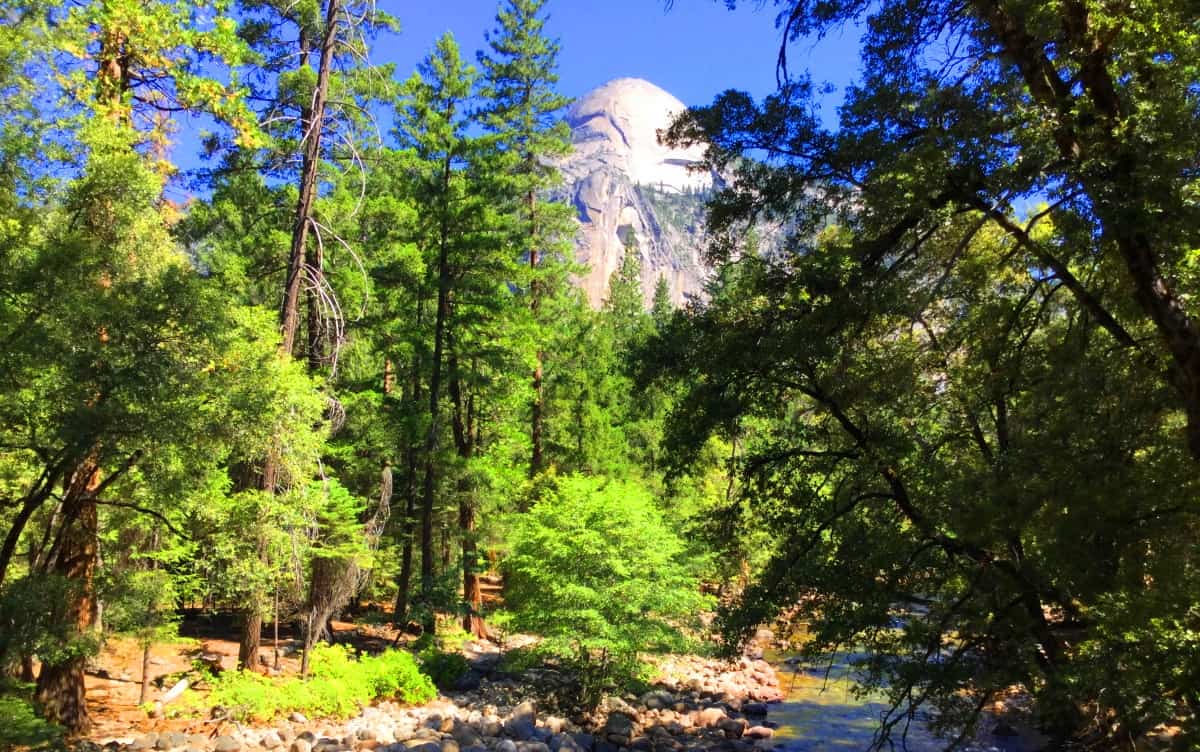
Yosemite is a near perfect enclosure, in terms of a potential indigenous living spaces. You don’t simply “look” here, like when when someone points out a new sky scraper in the city; here you cast your gaze upon the bright granite domes, 1000 foot waterfalls, and the vast central valley laid out like a pure earthen common. All of this is under ultimate protection by a massively-squared mountain jawline looming in the heights, all striking the senses in a dynamic cinematic ingestion. The image below is (Mount) El Capitaine, seen on the right, as if it were a crafted monument.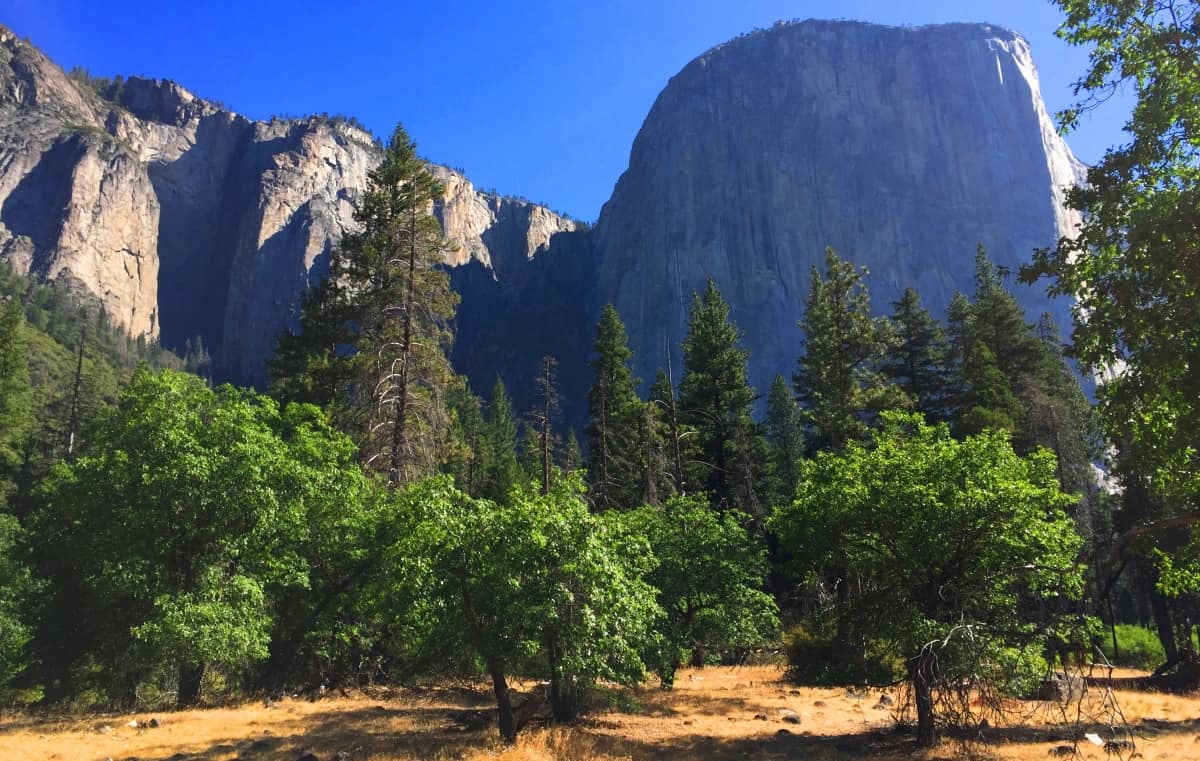 There are 16 trails in Yosemite Valley, and every one of them has exquisite traits and value. Beginner level trails like Lower Yosemite Falls, Mist Trail, and Artist Point, are great routes for conversation and catching up with loved ones. Those who are taking it easy for the day, encamped in the Valley, enjoy taking advantage of the relaxing views. (Image/Below)
There are 16 trails in Yosemite Valley, and every one of them has exquisite traits and value. Beginner level trails like Lower Yosemite Falls, Mist Trail, and Artist Point, are great routes for conversation and catching up with loved ones. Those who are taking it easy for the day, encamped in the Valley, enjoy taking advantage of the relaxing views. (Image/Below)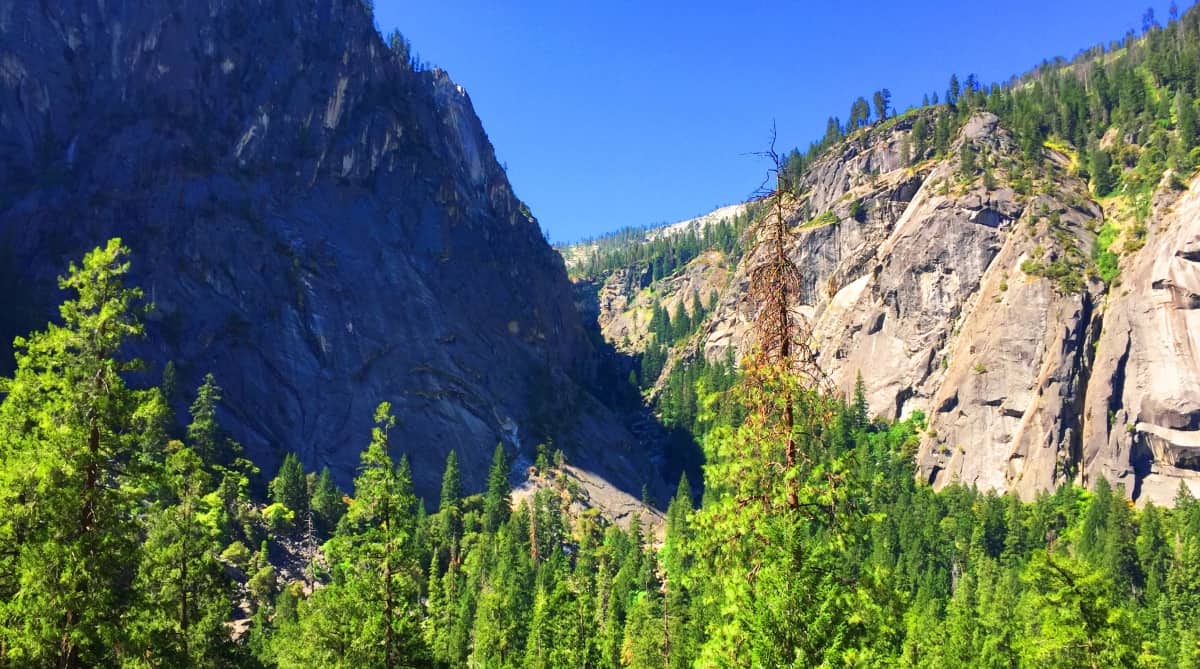 Mid-level trails like Upper Yosemite Falls, Snow Creek, and ‘Four Mile’ are kick-ass romps along well defined paths and patios which bend through the forest, follow wide rolling streams along towering waterfalls, which reveal double-rainbows at certain hours of the day. (Image/Below)
Mid-level trails like Upper Yosemite Falls, Snow Creek, and ‘Four Mile’ are kick-ass romps along well defined paths and patios which bend through the forest, follow wide rolling streams along towering waterfalls, which reveal double-rainbows at certain hours of the day. (Image/Below)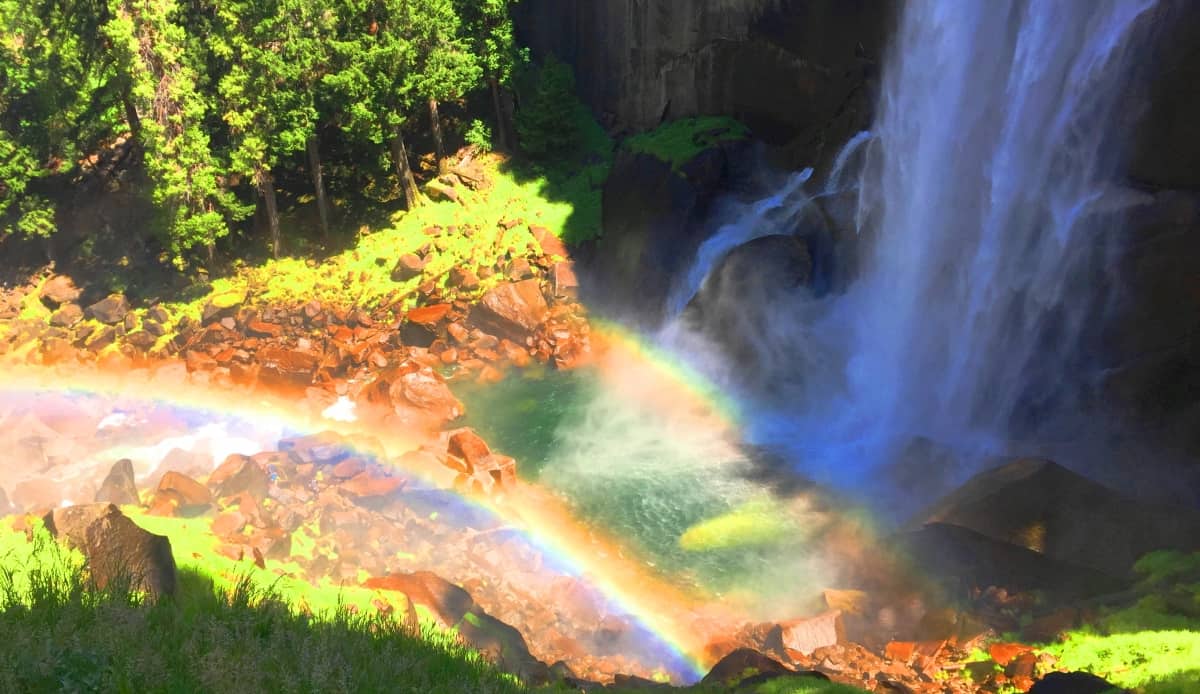 Amazing. The Hard level trails, like Pohono, and Half Dome, are expeditions that require physical and mental preparation. Pohono gets 5 full stars on All-Trails.com, and is loved for the brilliant vistas it climbs into, along with a beautiful scenic loop at the back end. Many hikers take-on Pohono with the intention to camp overnight, as the overall trail runs for about 20 miles of challenging inclines and rocky paths. The challenge of Pohono is well worth the reward, with once-in-a-lifetime photography happening, and great vibes throughout. Finally, the most challenging and famous trail is the Half Dome. The Half Dome is about 5000 feet of elevation cresting the entire Valley of Yosemite. The cut of the Valley from the west seems to emphasize the Half Dome, directing the eyes towards it like an ultimate centralizing fixture, sitting on the high mantle-piece of the Sierra Nevada Mountains. (Image/Below) On the left El Capitan is cut straight down, while on the right the Valley seems to lean away in order to let anyone coming from this direction visualize the shape at the dead center, The Half Dome.
Amazing. The Hard level trails, like Pohono, and Half Dome, are expeditions that require physical and mental preparation. Pohono gets 5 full stars on All-Trails.com, and is loved for the brilliant vistas it climbs into, along with a beautiful scenic loop at the back end. Many hikers take-on Pohono with the intention to camp overnight, as the overall trail runs for about 20 miles of challenging inclines and rocky paths. The challenge of Pohono is well worth the reward, with once-in-a-lifetime photography happening, and great vibes throughout. Finally, the most challenging and famous trail is the Half Dome. The Half Dome is about 5000 feet of elevation cresting the entire Valley of Yosemite. The cut of the Valley from the west seems to emphasize the Half Dome, directing the eyes towards it like an ultimate centralizing fixture, sitting on the high mantle-piece of the Sierra Nevada Mountains. (Image/Below) On the left El Capitan is cut straight down, while on the right the Valley seems to lean away in order to let anyone coming from this direction visualize the shape at the dead center, The Half Dome. 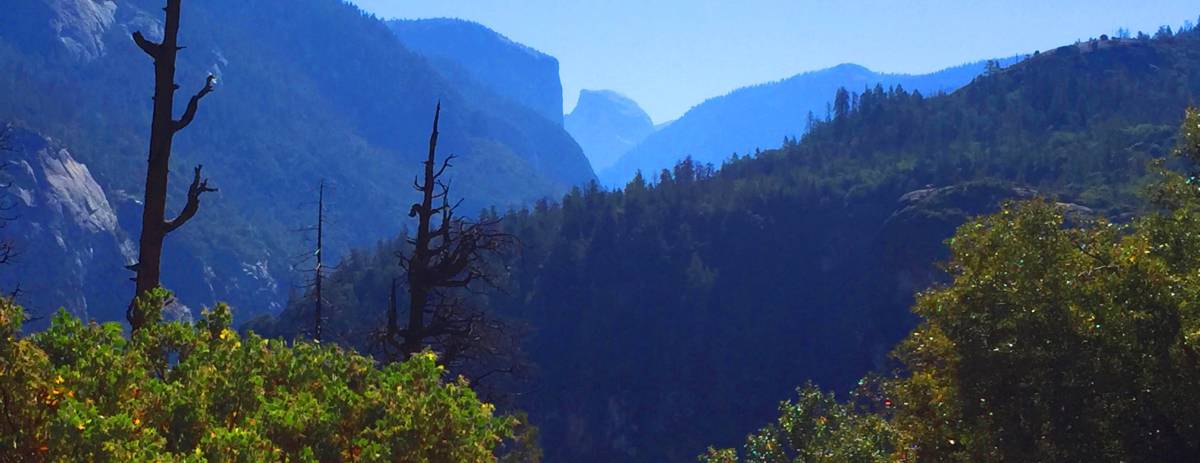 Half Dome Trail: Ok, let’s go for it! This is one of the most coveted and beautiful trails in the entire world. A few months before you go, there are a few things you will need to do. In a quick gloss-over, lets look at the essentials…
Half Dome Trail: Ok, let’s go for it! This is one of the most coveted and beautiful trails in the entire world. A few months before you go, there are a few things you will need to do. In a quick gloss-over, lets look at the essentials…
Half Dome/Preparation: In the months before you take on the Half Dome, you will need to purchase a small water purifying pump, and a water pack, filling it with at-least a gallon of water. You will also need a “sports drink”, or something with sugar, so you can keep your body wakeful while trekking up the Valley. Fill your pack with peanut-butter bars, energy bars, a sandwich or two, and some jelly-beans (but to celebrate only at the peak, and not before; The sugar is a an extra reward for your brain after a serious physical effort, but too much sugar along the way will burn too quickly in your digestion, creating less effective energy, and burn-you-out before the peak). Ingest food and drink strategically. Take bites and sips while you go, don’t eat or drink too much in one sitting on the way, or it will stifle your metabolism and physical rhythm, forcing your body to shift into digestional function, rather than the necessary motor focus…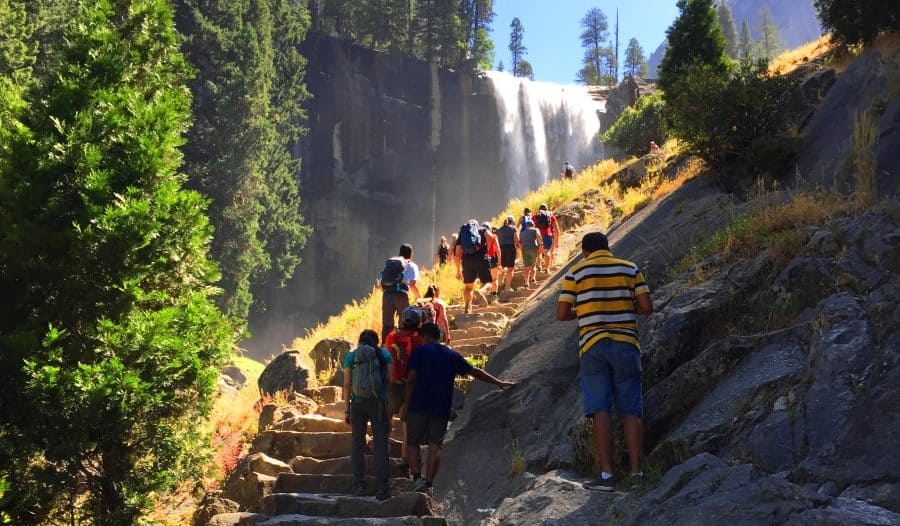 If you “down” drinks and food too quickly, fatigue will hit you hard, inducing lethargy. And last but not least, bring ITunes (headphones) that contain nothing less than the soundtrack to your life. Your favorite music during a tough climb can truly make the difference between making it, or feeling like you just can’t go on. Music is nutrition for your soul, and causes you to remember other climbs you’ve made, as well as good moments in your minds-eye, while you make your way. These are the basics of what you will need in your pack. Now you’re ready to rock-and-roll.
If you “down” drinks and food too quickly, fatigue will hit you hard, inducing lethargy. And last but not least, bring ITunes (headphones) that contain nothing less than the soundtrack to your life. Your favorite music during a tough climb can truly make the difference between making it, or feeling like you just can’t go on. Music is nutrition for your soul, and causes you to remember other climbs you’ve made, as well as good moments in your minds-eye, while you make your way. These are the basics of what you will need in your pack. Now you’re ready to rock-and-roll.
Half Dome (High Sierra): First and foremost, be inside Yosemite Valley just after sunrise to give yourself plenty of time to make the peak. Eat a good breakfast. Realize that during today’s climb you will be trekking a total of 16.4 miles, the first 8.2 of which is heading progressively up rocky stairs, misty cliffs-sides, and deep forests. Get a good last look at the Half Dome (Image/Below) before starting out, and then start towards the trail-head, which is a mile walk just beyond the main parkin- lot at Yosemite. 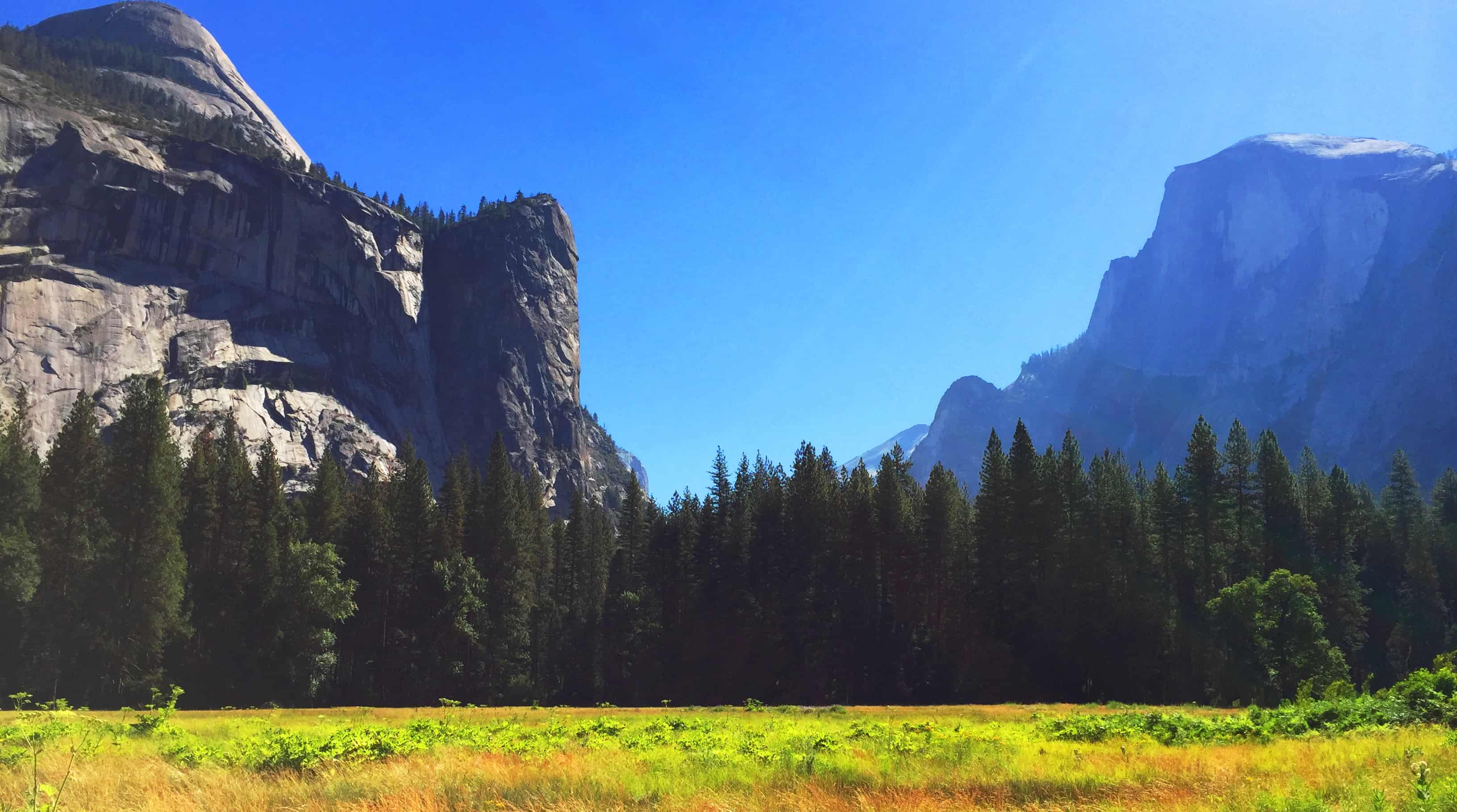 One of the toughest parts of this endurance challenge that you’re taking on is having enough strength in that 8th mile, by the peak, to free-climb a vertical wire-staircase that runs straight up the side of the Half Dome. Only then will you emerge at the peak at one of the most beautiful Valley’s in the world. Be capable of a very strong grip, and enough strength to keep your footing on the rock-face along the side of the Dome. After you get your head around these things, you are ready. And the most important thing to realize is that you can do it. Thousands of people make it to the peak here every year, and the trek along the way is simply once in a lifetime.
One of the toughest parts of this endurance challenge that you’re taking on is having enough strength in that 8th mile, by the peak, to free-climb a vertical wire-staircase that runs straight up the side of the Half Dome. Only then will you emerge at the peak at one of the most beautiful Valley’s in the world. Be capable of a very strong grip, and enough strength to keep your footing on the rock-face along the side of the Dome. After you get your head around these things, you are ready. And the most important thing to realize is that you can do it. Thousands of people make it to the peak here every year, and the trek along the way is simply once in a lifetime.
High Sierra Loop Trail: The High Sierra Loop Trailhead, for all the trails running out of the main Valley, is just a short walk beyond the Yosemite Valley Parking Lot and encampment area. You can just follow the foot-traffic of people literally funneling into the mountain heights, where the sign sits just above the starting path above the river. This is the High Sierra Trailhead “Rubicon”, from here you can no longer purchase water, or any other supplies. You’re on your own from here, and you’re ready for it.  But in a truly heart warming way, you can begin your climb among the company of families and seekers with the joy of an exodus, surrounded by that great vibe and assurance that each and every one of these people has left the office far, far behind. Fantastic domestic Rangers are also on hand throughout the trail to answer any questions, should any issues emerge. One of the coolest aspects of hiking through an Internationally acclaimed Park like Yosemite is that you can come across people from all over the world. In this excursion alone I spoke with people from at least half-a-dozen other countries. Another humbling realization can also come while speaking to Americans here. The North American continent is home to so many wonderful families and persuasions. Anyone who tells you that the American ‘moment’ has passed hasn’t gotten away from their television nearly enough these passed years. American families are wholesome, loving, caring, and truly wonderful down-to-earth people, of every creed and color; whether they be a large Latino unit from southern California, a Hindu-American couple from New York City, or a 7th generation European collective from the American Midwest; you can find them all here at Yosemite each and every year, soaking up beautiful and challenging Natural experiences, developing a deeper love for the Country in which they reside. And along the way, you might take a moment to realize that the Native Americans, the beautiful original caretakers of this wilderness, are for the most part, gone. This is a good place to let such a thought sink in. Let it sink in, then let it go; you have a mountain to climb.
But in a truly heart warming way, you can begin your climb among the company of families and seekers with the joy of an exodus, surrounded by that great vibe and assurance that each and every one of these people has left the office far, far behind. Fantastic domestic Rangers are also on hand throughout the trail to answer any questions, should any issues emerge. One of the coolest aspects of hiking through an Internationally acclaimed Park like Yosemite is that you can come across people from all over the world. In this excursion alone I spoke with people from at least half-a-dozen other countries. Another humbling realization can also come while speaking to Americans here. The North American continent is home to so many wonderful families and persuasions. Anyone who tells you that the American ‘moment’ has passed hasn’t gotten away from their television nearly enough these passed years. American families are wholesome, loving, caring, and truly wonderful down-to-earth people, of every creed and color; whether they be a large Latino unit from southern California, a Hindu-American couple from New York City, or a 7th generation European collective from the American Midwest; you can find them all here at Yosemite each and every year, soaking up beautiful and challenging Natural experiences, developing a deeper love for the Country in which they reside. And along the way, you might take a moment to realize that the Native Americans, the beautiful original caretakers of this wilderness, are for the most part, gone. This is a good place to let such a thought sink in. Let it sink in, then let it go; you have a mountain to climb.
 So this is where your expedition truly begins. There is little concern about getting lost here; signs for the Half Dome are placed along the trail. Remember to stay within eye shot of the trail while hiking, and that this is a very real wildlife reserve, with emphasis on wild life. Black Bears (who are actually Brown in color), Black Tailed Deer, and a myriad of creatures are at play here at all times, so be aware, and don’t wander off. The first few miles of the lower trail is a comfortable and scenic concrete path, warming you up for the rocky incline bringing you towards the brilliant Vernal Fall, and then Nevada Fall running along the mighty Merced River.
So this is where your expedition truly begins. There is little concern about getting lost here; signs for the Half Dome are placed along the trail. Remember to stay within eye shot of the trail while hiking, and that this is a very real wildlife reserve, with emphasis on wild life. Black Bears (who are actually Brown in color), Black Tailed Deer, and a myriad of creatures are at play here at all times, so be aware, and don’t wander off. The first few miles of the lower trail is a comfortable and scenic concrete path, warming you up for the rocky incline bringing you towards the brilliant Vernal Fall, and then Nevada Fall running along the mighty Merced River. On this comfortable lower trail take the opportunity to put your head-phones on and get some music going before the incline begins. One of the most challenging portions of the overall hike is coming up; a towering set of stone steps that will lead you above both waterfalls, with an interval of Forest in between. Take several halts to appreciate the path you are on, and rest. This is a rare cinematic path that historically significant souls have treaded, drawing inspiration and peace-of mind with each bend in the trail. There are places for quiet moments and rest, as well as very public forums of interaction by the small lakes in the heights. Realize that you are entering an elevated wonderland.
On this comfortable lower trail take the opportunity to put your head-phones on and get some music going before the incline begins. One of the most challenging portions of the overall hike is coming up; a towering set of stone steps that will lead you above both waterfalls, with an interval of Forest in between. Take several halts to appreciate the path you are on, and rest. This is a rare cinematic path that historically significant souls have treaded, drawing inspiration and peace-of mind with each bend in the trail. There are places for quiet moments and rest, as well as very public forums of interaction by the small lakes in the heights. Realize that you are entering an elevated wonderland. 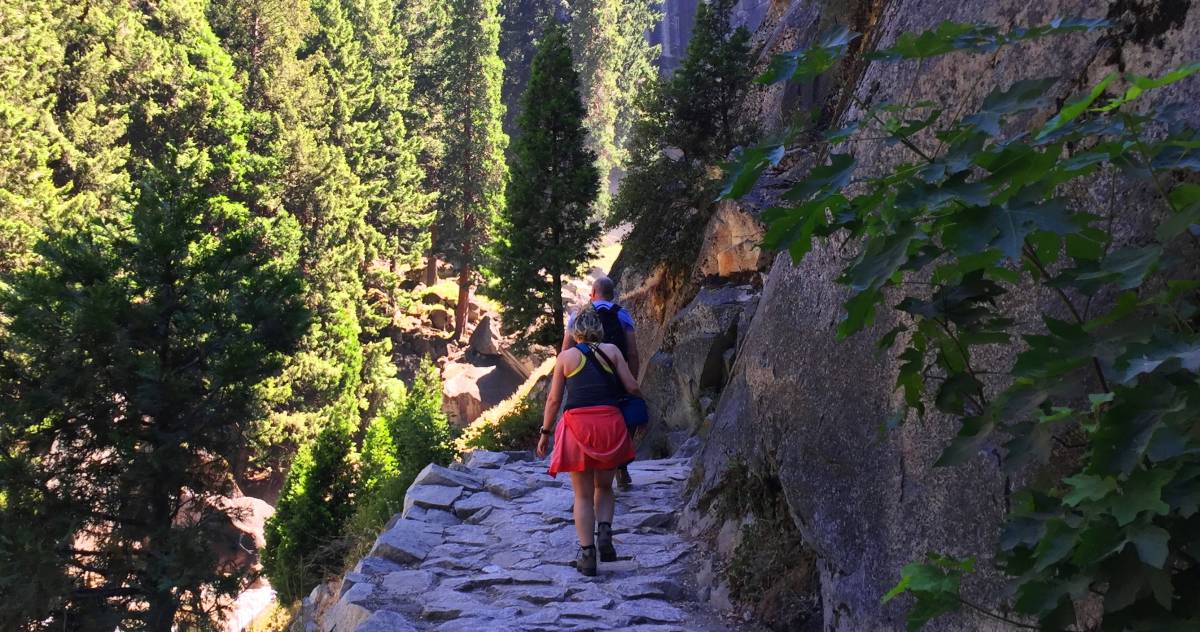 Leaving the lower concrete path behind, a new rocky path will take you towards the grandeur of Vernal Falls. The grand incline begins. You will need to watch your step, not just for your own safety, but for the other people making their way as well. The vibe starts to get a little crazy! Rainbows appear in the mist all over the place, and a view of the harrowing, yet enticing, heights emerge above and beyond.
Leaving the lower concrete path behind, a new rocky path will take you towards the grandeur of Vernal Falls. The grand incline begins. You will need to watch your step, not just for your own safety, but for the other people making their way as well. The vibe starts to get a little crazy! Rainbows appear in the mist all over the place, and a view of the harrowing, yet enticing, heights emerge above and beyond.
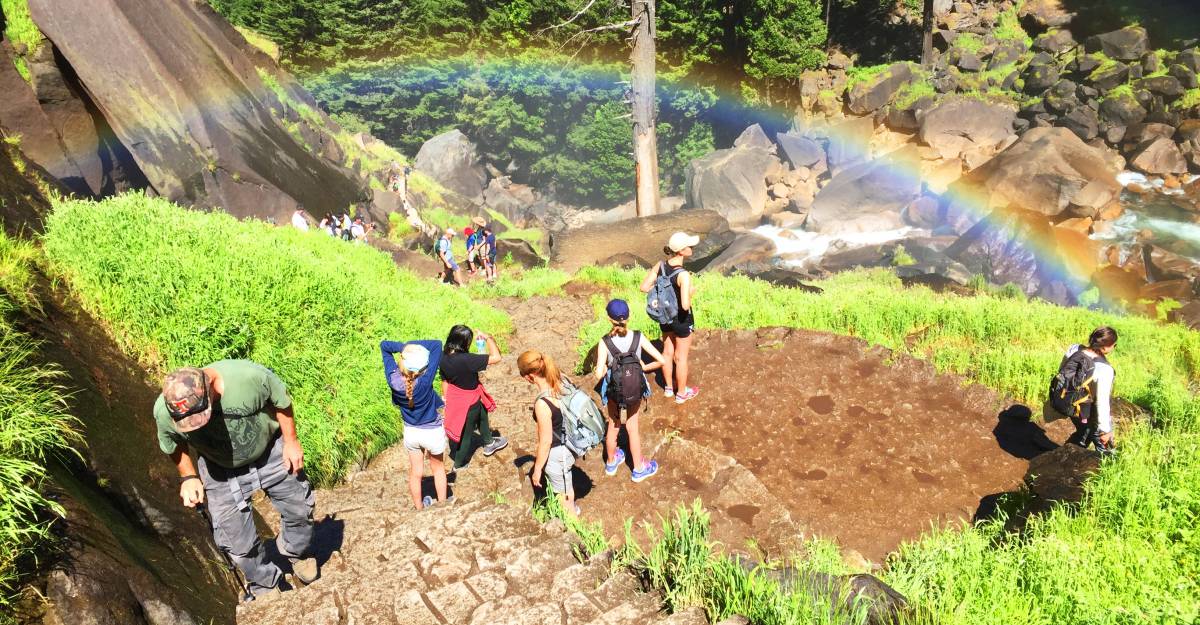 The Rainbow Factory: Stepping up to Vernal Falls is a negotiation with other hikers. Share the narrow trail and keep your footing. In many places you will need to use your hands to lift yourself along.
The Rainbow Factory: Stepping up to Vernal Falls is a negotiation with other hikers. Share the narrow trail and keep your footing. In many places you will need to use your hands to lift yourself along.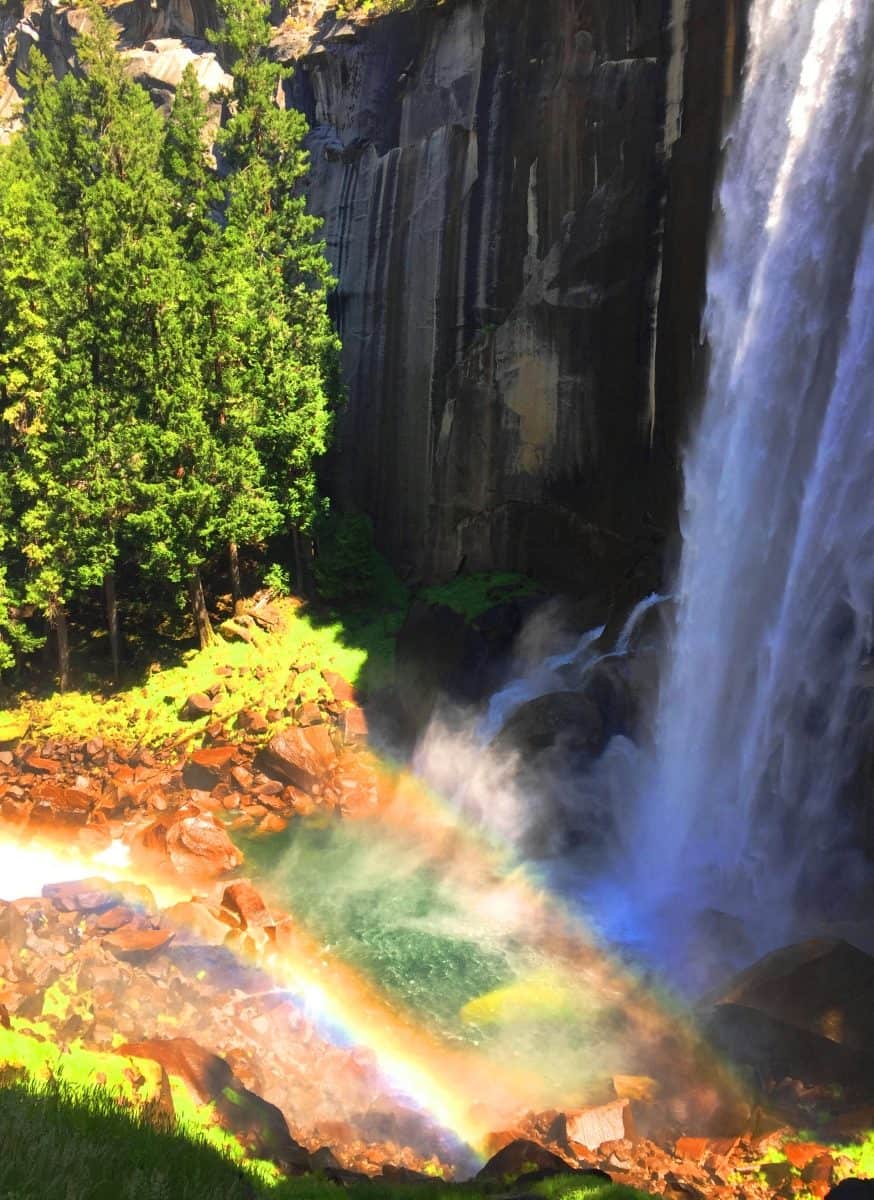 A cool mist begins to envelop everyone, giving a shimmer to literally everything you see. If the Sun is out the effect is supreme, and the Sun is almost always out. This is a drop the size of a vertically hanging football field. Here there is a bold geological contrast worth noting. The gigantic granite escarpment looks like a section of a modern dam, with linear parallel shafts sliding at a perfect 90 degree angle straight to the bottom. And at the bottom, a collection of boulders is sitting, precisely piled, at the point of impact of the forceful flow of water. It almost looks like a mechanized effect. In mathematical terms, the height of the waterfall determines the amount of acceleration the water experiences coming down; And the greater the acceleration, the greater the impact and size of the mist that will emerge. With an appropriate vantage on the Sun, Vernal Falls is literally a waterfall factory. Neolithic historians are able to see the possibility of design in a place. On this website alone are several waterfalls that seemed to be engineered in the Neolithic Era, like Bear’s Den Falls’ in New Salem Massachusetts, or the indigenous Falls’ of Donegal Ireland. Regardless if this, whether this is an intended Neolithic site or not, it is enough to sit back and accept the incredible beauty it has produced for over 12000 years. This is part of the Mist Trail Loop, and a lot of people at this point will head back down from here; in the upcoming forest you will feel an increased quiet. First, as you climb the narrow stair above Vernal Fall, you will come to a Lake that is the color of hard jade, radiating beneath the trees.
A cool mist begins to envelop everyone, giving a shimmer to literally everything you see. If the Sun is out the effect is supreme, and the Sun is almost always out. This is a drop the size of a vertically hanging football field. Here there is a bold geological contrast worth noting. The gigantic granite escarpment looks like a section of a modern dam, with linear parallel shafts sliding at a perfect 90 degree angle straight to the bottom. And at the bottom, a collection of boulders is sitting, precisely piled, at the point of impact of the forceful flow of water. It almost looks like a mechanized effect. In mathematical terms, the height of the waterfall determines the amount of acceleration the water experiences coming down; And the greater the acceleration, the greater the impact and size of the mist that will emerge. With an appropriate vantage on the Sun, Vernal Falls is literally a waterfall factory. Neolithic historians are able to see the possibility of design in a place. On this website alone are several waterfalls that seemed to be engineered in the Neolithic Era, like Bear’s Den Falls’ in New Salem Massachusetts, or the indigenous Falls’ of Donegal Ireland. Regardless if this, whether this is an intended Neolithic site or not, it is enough to sit back and accept the incredible beauty it has produced for over 12000 years. This is part of the Mist Trail Loop, and a lot of people at this point will head back down from here; in the upcoming forest you will feel an increased quiet. First, as you climb the narrow stair above Vernal Fall, you will come to a Lake that is the color of hard jade, radiating beneath the trees.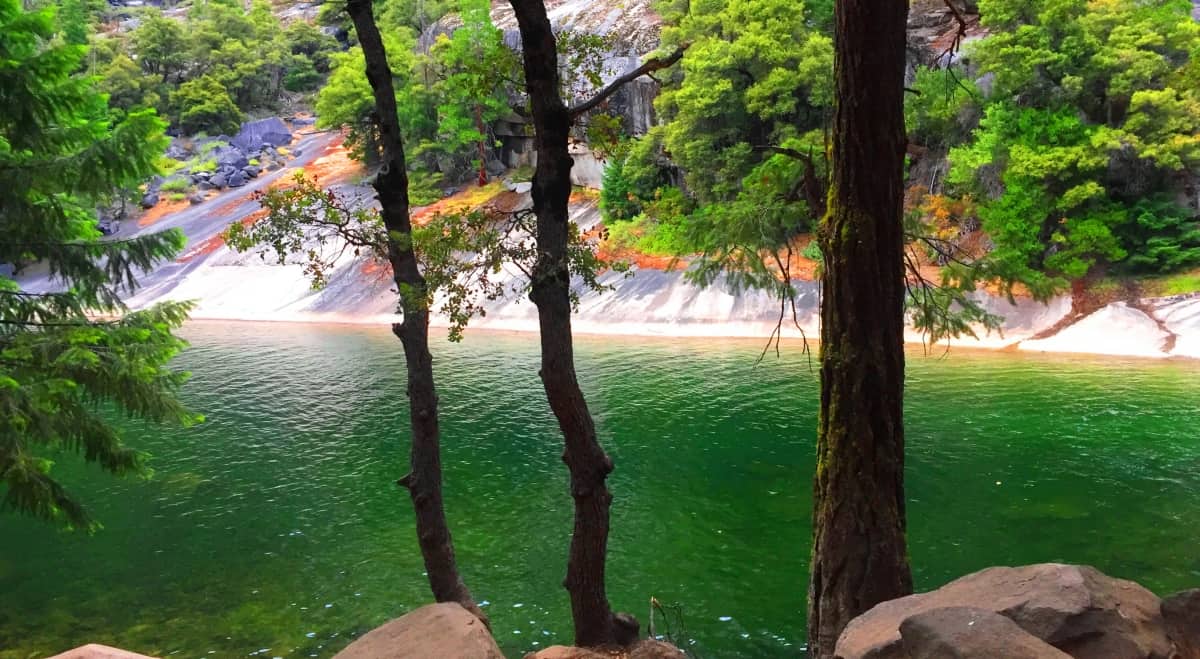 Nevada Falls: The tranquility aspect of this expedition starts to set-in once you head into the forest just below Nevada Falls. There is something about the consistency in the granite, the white-grey gardens of stone that have been collected into steps, which is comforting. The mountain is what it is.
Nevada Falls: The tranquility aspect of this expedition starts to set-in once you head into the forest just below Nevada Falls. There is something about the consistency in the granite, the white-grey gardens of stone that have been collected into steps, which is comforting. The mountain is what it is. 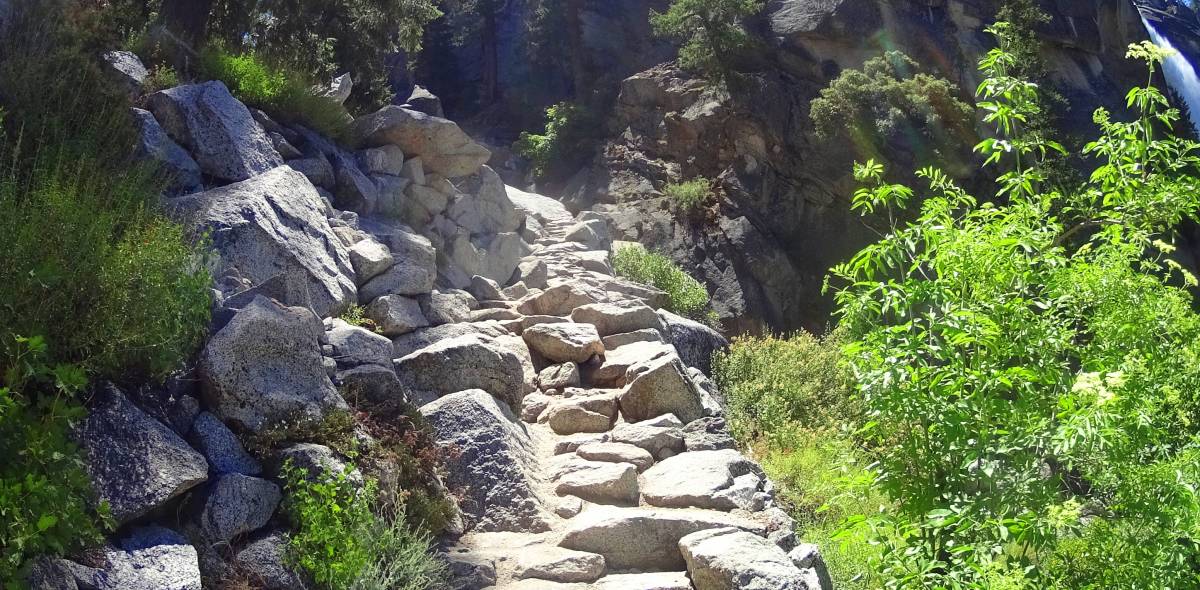 The clean consistency of color and contrast, and the specifying your steps along these crags, creates a type of vindication for each and every hiker. There is no shortcut here. As the real work of the incline sets in, you are relating to the specific characteristics of this particular mountain, which is truly a touching, and at times refined beauty. Combine all this with the boundless foundational force beneath you, and you will be taking-in the energies of the climb of a lifetime.
The clean consistency of color and contrast, and the specifying your steps along these crags, creates a type of vindication for each and every hiker. There is no shortcut here. As the real work of the incline sets in, you are relating to the specific characteristics of this particular mountain, which is truly a touching, and at times refined beauty. Combine all this with the boundless foundational force beneath you, and you will be taking-in the energies of the climb of a lifetime. 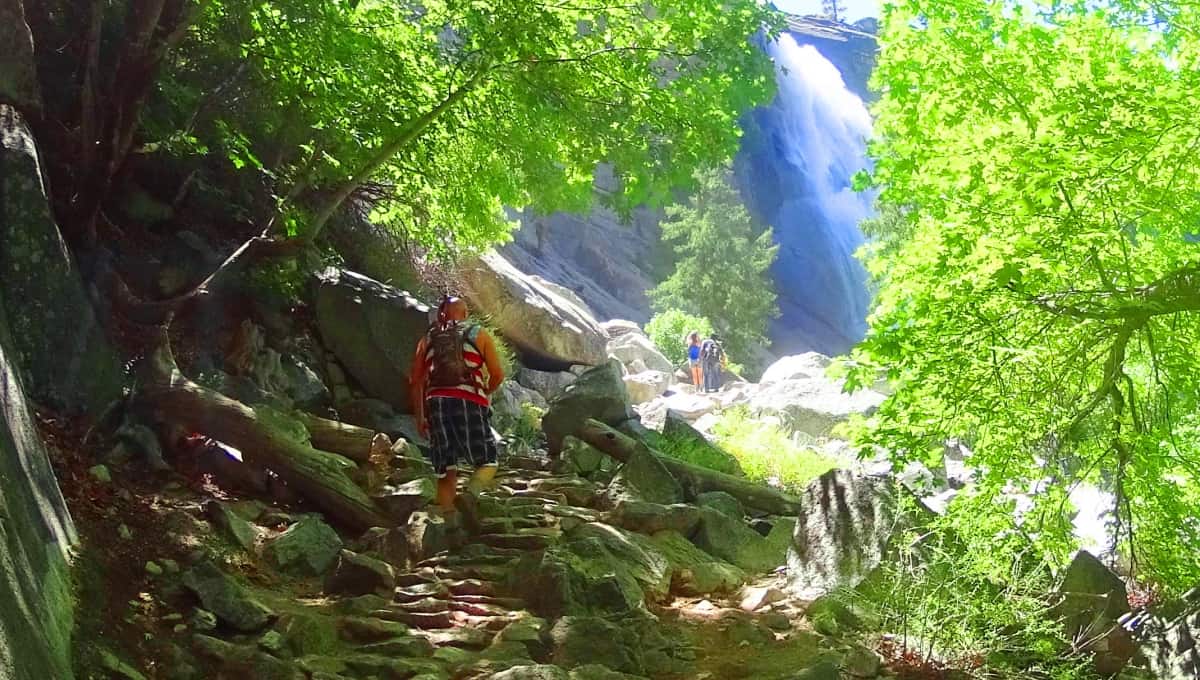 Getting above Nevada Falls is no small feat. You’ve climbed for about 3.5 miles, which means your total hike will be about 7 miles if you decide to loop-it back down. There is a crossroads up here. To take a right at the top of this Fall is to begin heading back down along the loop, but to take a right is to head towards the Half Dome. At this point you have expended a good deal of energy. It might be a good idea to take a few minutes and dunk your body in the cool of the Merced River, which runs along the base of the Sequoia Forest, before beginning the switchback inclines of the high glade. Cool yourself down before going on, it goes over like a baptism after the climb you just made (Image/Below)
Getting above Nevada Falls is no small feat. You’ve climbed for about 3.5 miles, which means your total hike will be about 7 miles if you decide to loop-it back down. There is a crossroads up here. To take a right at the top of this Fall is to begin heading back down along the loop, but to take a right is to head towards the Half Dome. At this point you have expended a good deal of energy. It might be a good idea to take a few minutes and dunk your body in the cool of the Merced River, which runs along the base of the Sequoia Forest, before beginning the switchback inclines of the high glade. Cool yourself down before going on, it goes over like a baptism after the climb you just made (Image/Below)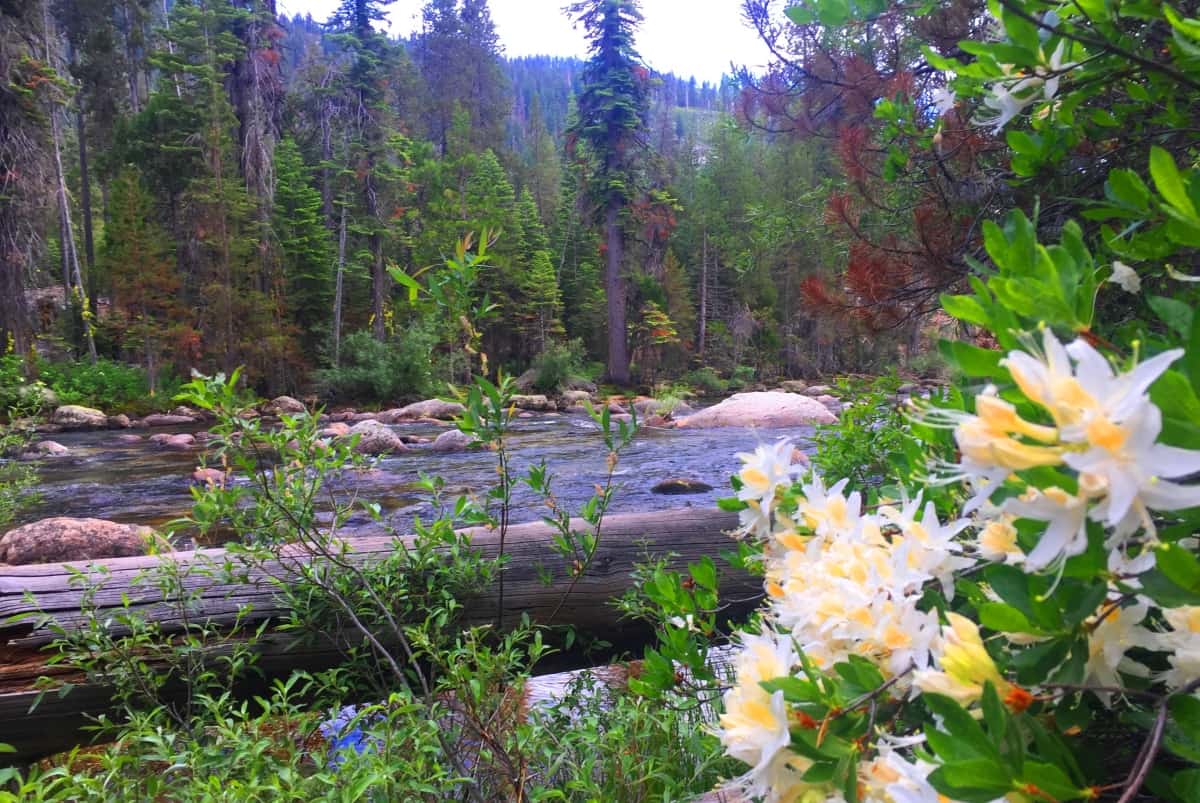 From here the amount of people you see dwindles into quieter singularity, yet again. Those heading back down will wish you luck as you take a right turn, and head towards the high Sequoia Forest trail which dreamily precedes the ultimate goal above. John Muir wrote of this glade: “The coniferous Forests of the Yosemite Park, and of the Sierra in general, surpass all other of their kind in America or indeed the world, not only in size and beauty of the trees, but in the number of species assembled together, and the grandeur of the mountains they are growing on.” This is where you are.
From here the amount of people you see dwindles into quieter singularity, yet again. Those heading back down will wish you luck as you take a right turn, and head towards the high Sequoia Forest trail which dreamily precedes the ultimate goal above. John Muir wrote of this glade: “The coniferous Forests of the Yosemite Park, and of the Sierra in general, surpass all other of their kind in America or indeed the world, not only in size and beauty of the trees, but in the number of species assembled together, and the grandeur of the mountains they are growing on.” This is where you are.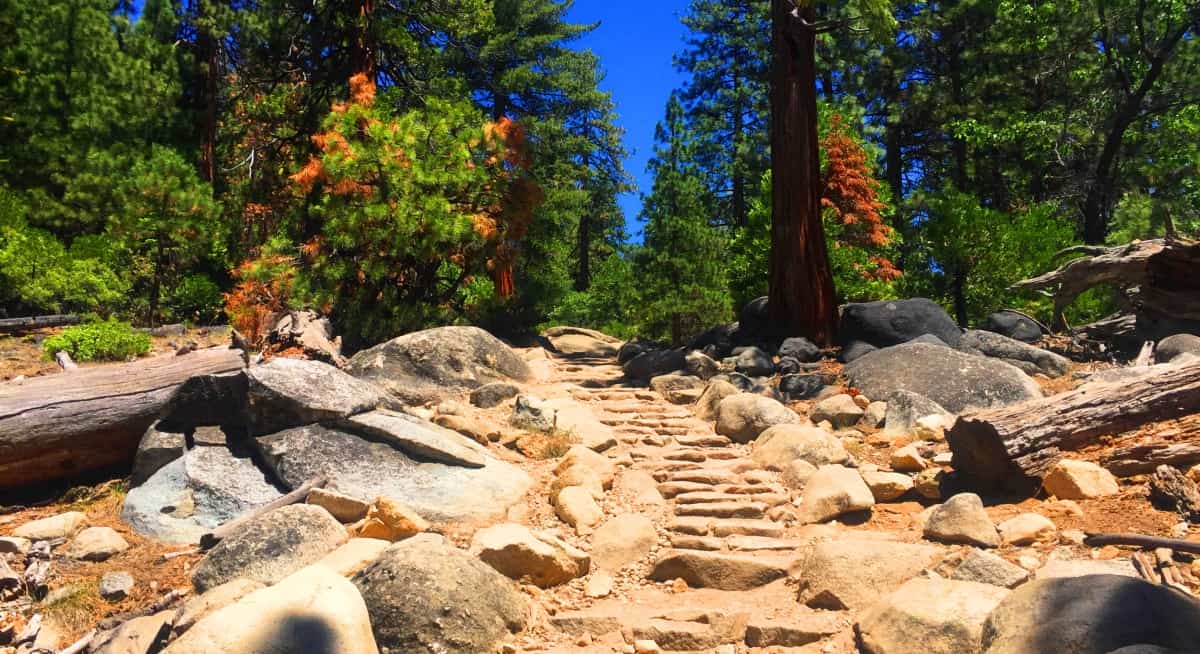 Trekking among these Sequoias and Birches 4000 feet above the Valley brings on the sudden feeling of quietude. After moving alongside stretches of rushing and falling water for the last 3 miles of incline, you will feel a distinct and pristine stillness. Footfall here is light and padded among the one mile stretch of dry sand that leads into the forest; the trees roll-out a venerable carpet of soft pine-needles. leaves, and rusty moss, and feels almost hollow beneath the soil, compared to the previous impactful reality of the granite stairs. The vibe changes. The coolness of the shade, along with the sudden rustiness of colors, both above and below, re-boots your perspective. And you feel as if the Forest is listening, which in truth, it is, and in more ways than most of us realize.
Trekking among these Sequoias and Birches 4000 feet above the Valley brings on the sudden feeling of quietude. After moving alongside stretches of rushing and falling water for the last 3 miles of incline, you will feel a distinct and pristine stillness. Footfall here is light and padded among the one mile stretch of dry sand that leads into the forest; the trees roll-out a venerable carpet of soft pine-needles. leaves, and rusty moss, and feels almost hollow beneath the soil, compared to the previous impactful reality of the granite stairs. The vibe changes. The coolness of the shade, along with the sudden rustiness of colors, both above and below, re-boots your perspective. And you feel as if the Forest is listening, which in truth, it is, and in more ways than most of us realize. 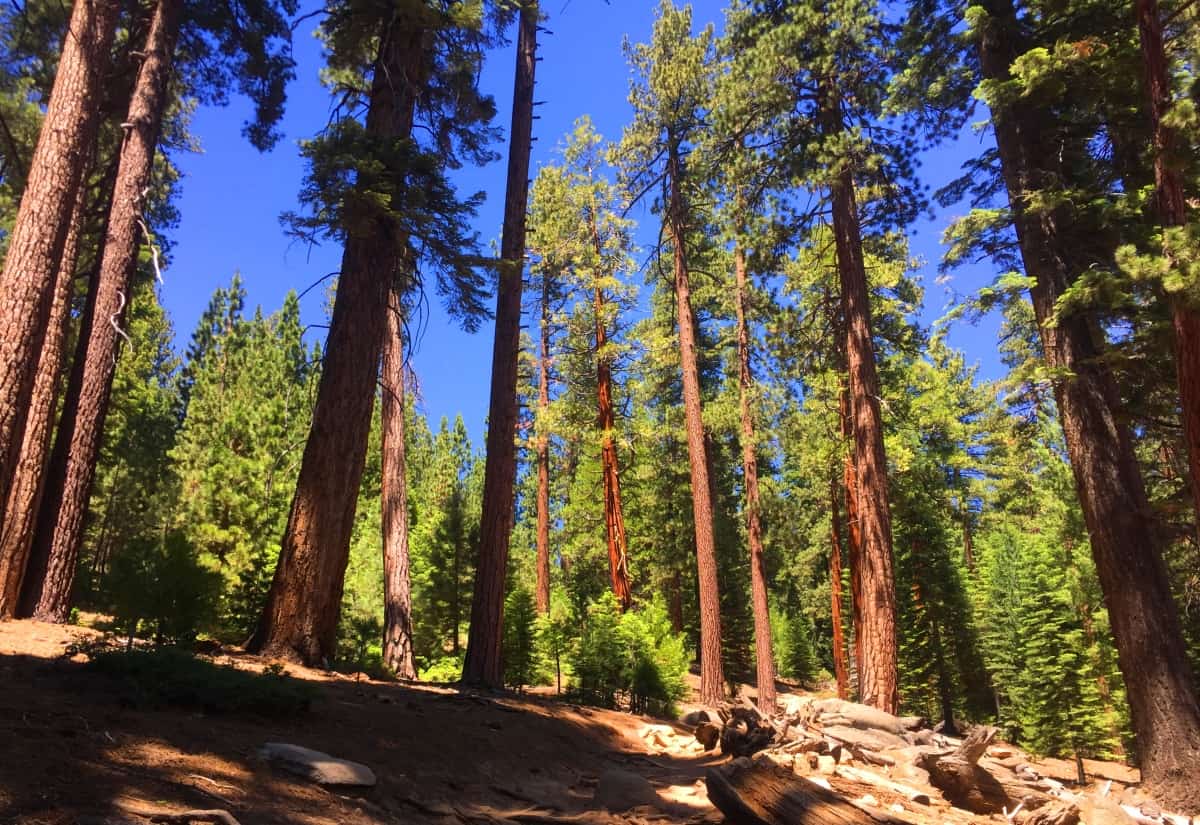 The effort to break the tree-line will carry you over huge root-kingdoms and boulders, all meshed together and mingled into a dry, but somehow lush looking fauna. Take advantage of the shade and snack a bit here. You may hear an owl, see a family of chipmunks zig-zagging just above the brush, or a deer drift by, soft and fair as a feather.
The effort to break the tree-line will carry you over huge root-kingdoms and boulders, all meshed together and mingled into a dry, but somehow lush looking fauna. Take advantage of the shade and snack a bit here. You may hear an owl, see a family of chipmunks zig-zagging just above the brush, or a deer drift by, soft and fair as a feather. 
Breaking the tree-line at any mountain is a powerful experience. I was reminded of the distinct and abrupt breaching of the tree-line at Mount Katahdin in Maine many years before. It’s amazing how other moments can effortlessly appear in your minds eye, and combine to create a sort of Zen collage of similar moments and mountain ranges. In both vision, and sensation, getting above the Forest leads to that final approach you’ve been pushing all day for. And in the distance, in this particular instance, is the Half Dome, a solid granite semi-sphere kissing the sky through the trees. From here things get other-worldly. All of a sudden beneath your feet is what feels like a single ovular stone, from which trees are still growing, like the Moon if it had an atmosphere. Follow the impressions of footfall in the sandy rock face, heading towards the Half Dome. There is one last incline of stone stairs cut into the rock before you come face to face with the most monumental peak in the United States. After about a half hour of slow work stepping up through the stones, the incredible scene opens up. Step up and come about, and cast your gaze North. This is the roof of California.
From here things get other-worldly. All of a sudden beneath your feet is what feels like a single ovular stone, from which trees are still growing, like the Moon if it had an atmosphere. Follow the impressions of footfall in the sandy rock face, heading towards the Half Dome. There is one last incline of stone stairs cut into the rock before you come face to face with the most monumental peak in the United States. After about a half hour of slow work stepping up through the stones, the incredible scene opens up. Step up and come about, and cast your gaze North. This is the roof of California.
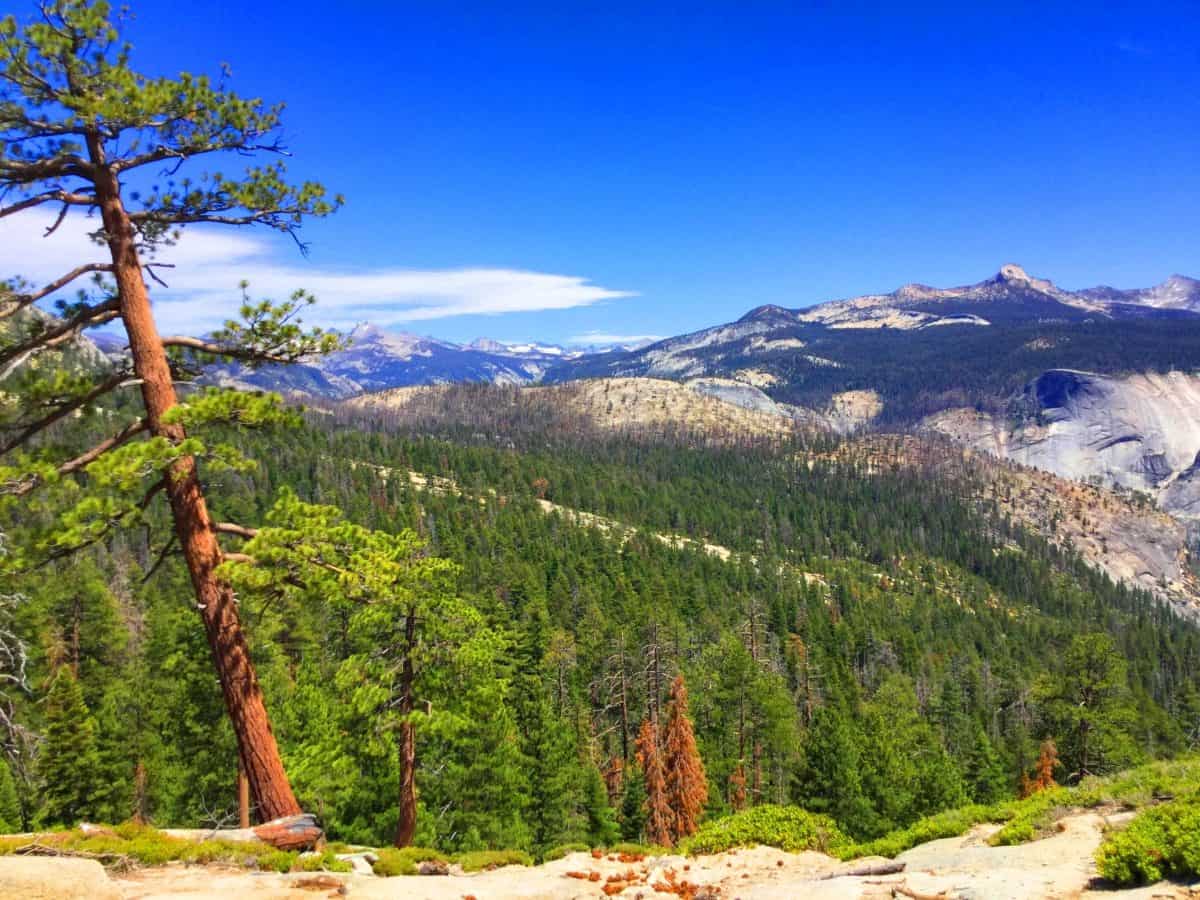 As you do an about-face there is an exhilaration. On this massive stone porch laid out before you is a small collective of the most determined climbers on the West Coast. Just beyond is what looks like a line, even smaller than ants, crawling up a vertical stretch of monolithic stone, the one which John Muir described as “like a god”. Those ants, of course, are not ants at all, but people. This is the final phase. You’re about to climb the length of 1.5 football fields, straight, up. You didn’t come all this way to turn back now. Get a good drink of water, and your bearings, and off you go.
As you do an about-face there is an exhilaration. On this massive stone porch laid out before you is a small collective of the most determined climbers on the West Coast. Just beyond is what looks like a line, even smaller than ants, crawling up a vertical stretch of monolithic stone, the one which John Muir described as “like a god”. Those ants, of course, are not ants at all, but people. This is the final phase. You’re about to climb the length of 1.5 football fields, straight, up. You didn’t come all this way to turn back now. Get a good drink of water, and your bearings, and off you go.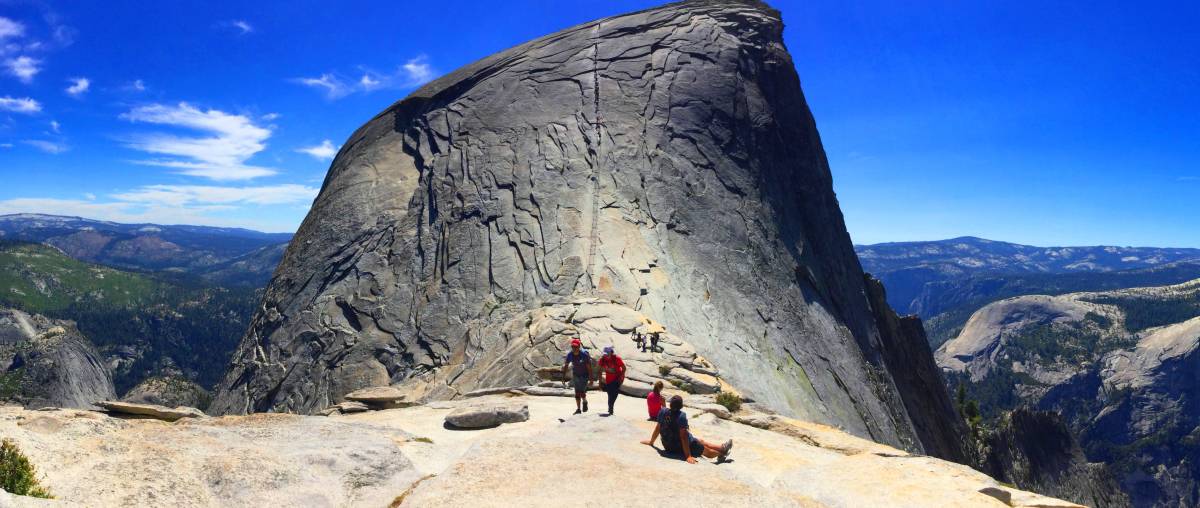 Imagine free climbing a 150 yard vertical set of wires at 5000 feet, with people coming both up and down, while you make your own way. Your grip must be absolute, but also relaxed somehow. Adrenaline kicks in. You get that “How the f$ck did I get here” type feeling. But push up through the sections of wooden supports between the wires, and in about a half hour, you should make the peak. Try not to look down until the Dome starts to level off beneath your feet, and then the whole world will be beneath you.
Imagine free climbing a 150 yard vertical set of wires at 5000 feet, with people coming both up and down, while you make your own way. Your grip must be absolute, but also relaxed somehow. Adrenaline kicks in. You get that “How the f$ck did I get here” type feeling. But push up through the sections of wooden supports between the wires, and in about a half hour, you should make the peak. Try not to look down until the Dome starts to level off beneath your feet, and then the whole world will be beneath you.
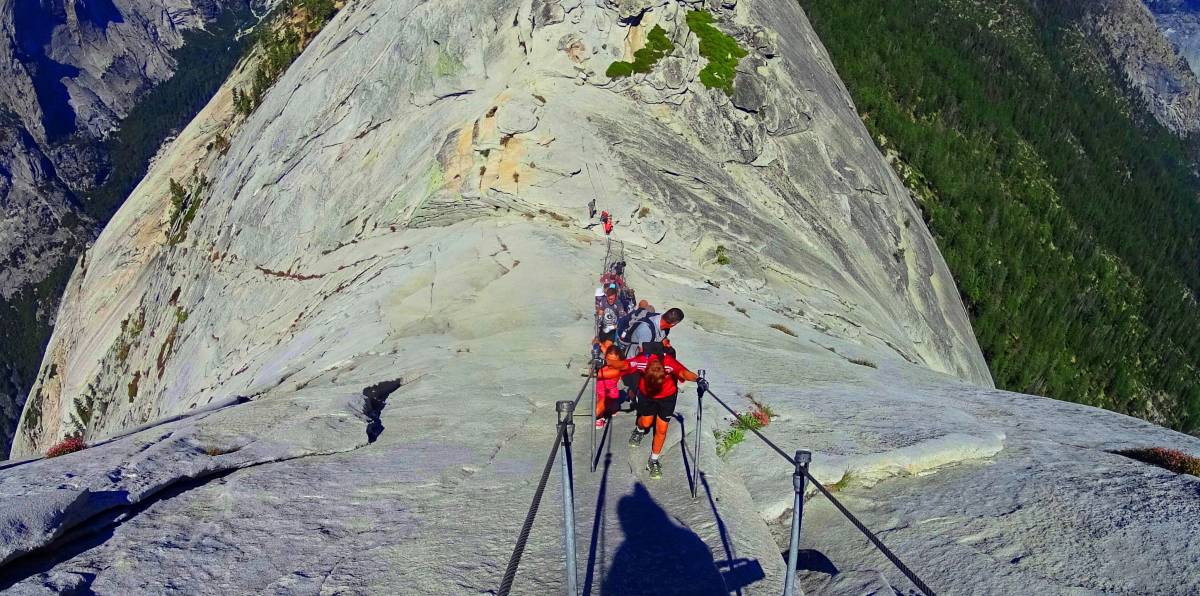 And then finally, you arrive. There is no other purpose to be up here, save for the spiritual one. There are no trees, no water, no hunting game of any kind. There is a purity in this context, that all non-essentials, both in attitude and physical effort, have melted away. If you carry too much in your bag, or your heart, it will make the challenge that much harder. So if you make it, you will, for at least a few spectacular moments, have a more essential picture of yourself.
And then finally, you arrive. There is no other purpose to be up here, save for the spiritual one. There are no trees, no water, no hunting game of any kind. There is a purity in this context, that all non-essentials, both in attitude and physical effort, have melted away. If you carry too much in your bag, or your heart, it will make the challenge that much harder. So if you make it, you will, for at least a few spectacular moments, have a more essential picture of yourself. 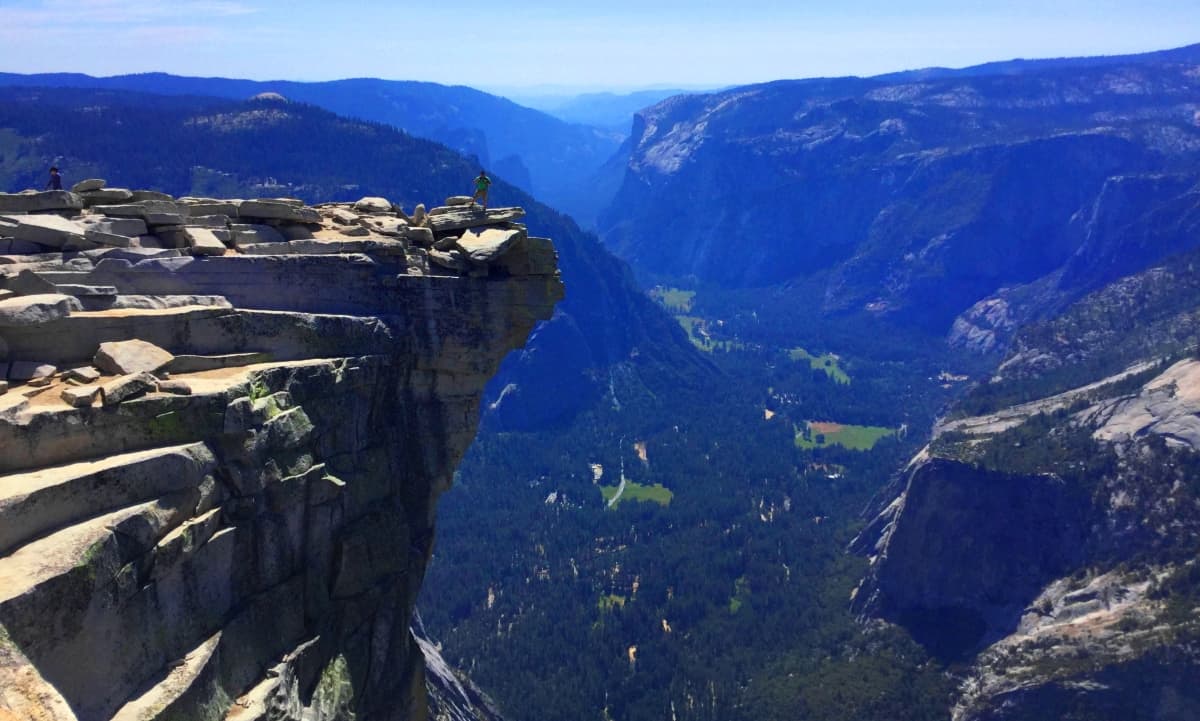
Now you can eat the Jelly Beans.
Spend some time to quietly celebrate up here. Take some photos, give thanks, but don’t wait too long, you have to make your way back down. The return trek might feel as if you are chasing the Sun. Light shifts along the Valley, changing the way the wilderness looks, with softened glows and down angles as you glide past with the benefit of gravity. Things cool down. The most important thing to keep in mind is your ankles. Be mindful of your steps, that you are landing flat, without obstruction. A stone or pine cone beneath your boot will roll your foot over, especially with the help of the extra bit of gravity. Use your back side and hands too, as you make your way down the winding stone stairs. Slide along where you can, and soon you will find you are descending beneath the waterfalls, with not even one fifth of the people that were trekking in the morning. You need to make good time here if you are going to make it back before Sunset. Hydrate, snack, and think about the well earned dinner awaiting you.

End of The Epic Day: Just yesterday MSN published an article about the 12 deadliest recreation sites in the world, sites that people just keep showing up for each year, due to their beauty and mystique. Guess what climb is number 12 on the international list? That’s right…Half Dome. Folks like John Muir or Teddy Roosevelt, back when, didn’t climb to the Half Dome in the same way we do; they perused the landscape, trekking with Natives or shepherds, slowly feeding their flocks along the way, or hunting quietly up the Valley. We are an ultra-modern culture these days, and to our detriment, speed is everything. The faster we do things, the more likely we are to be seen as innovative, and this definitely effects the way people hike in a place like Yosemite. Y0u can see it in the way people move, or lack there of. You need to have a focused and steady mentality here, one of respect for the landscape, and awareness of how you really feel. People literally die trying to make this climb, for lack of planning, or for lack of inner knowledge of what they are capable of. You’ve got to be ready for this place. It is one of the most challenging single day hikes on Earth. All the trimmings are there: ridiculous views…
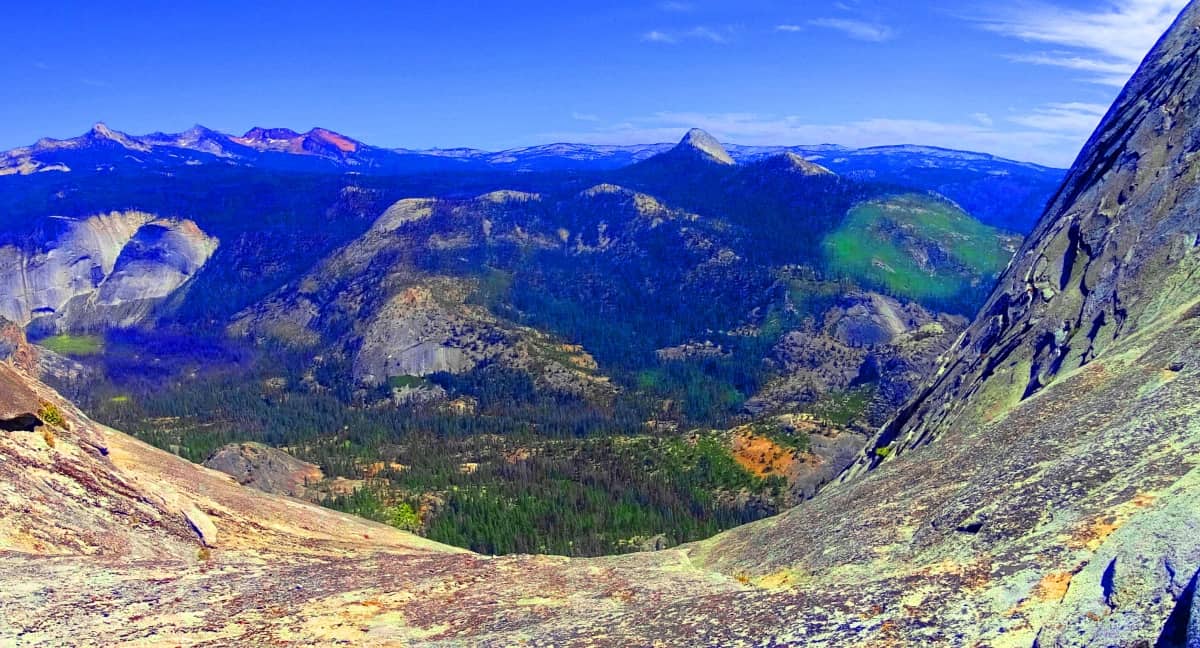 …realizations, interactions, cool moments, everything; but make sure you come prepared. If you do these things, you will arrive, with your last reserve of energy, to the Valley floor just in time to see the Sun setting behind the Yosemite ridges.
…realizations, interactions, cool moments, everything; but make sure you come prepared. If you do these things, you will arrive, with your last reserve of energy, to the Valley floor just in time to see the Sun setting behind the Yosemite ridges. 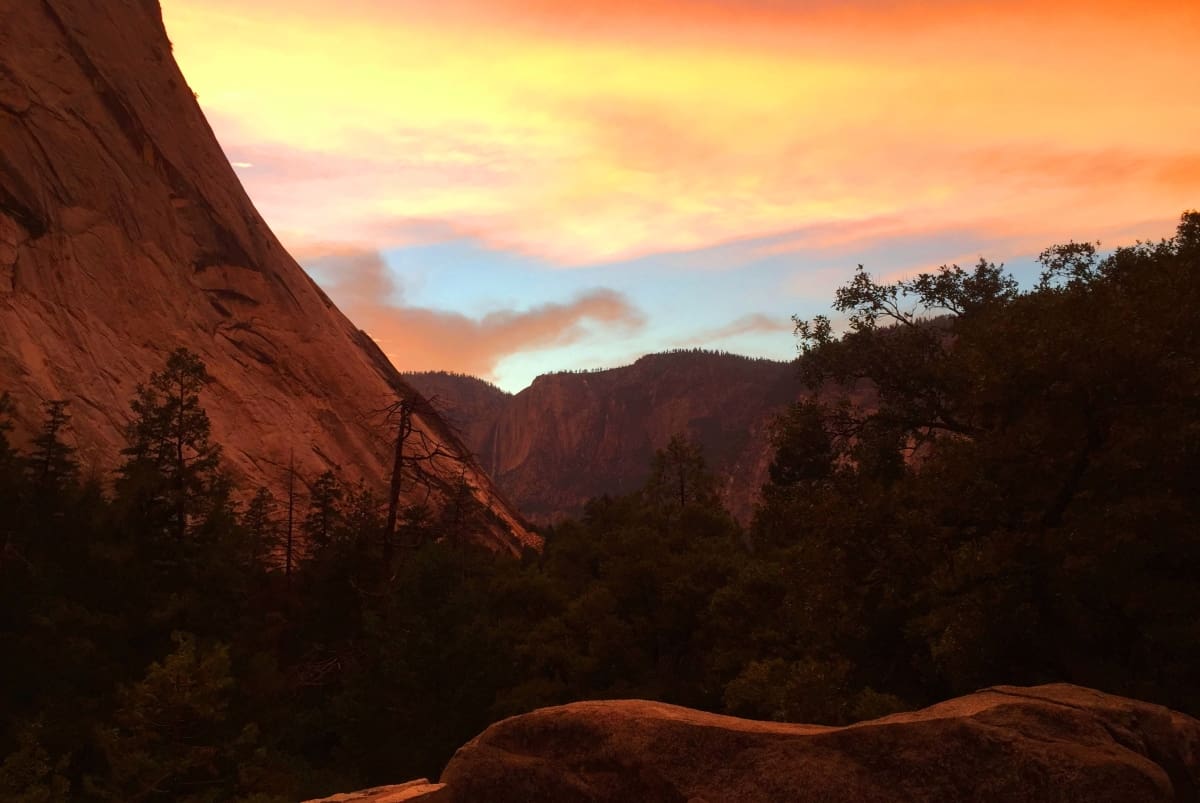 What you take with you from here, is the inner understanding of what you’ve learned about yourself; And believe me, one of those things should be that you have the juice to make an ultimately beautiful moment, out of even the toughest of climbs. Take that back into the world with you, if you take anything. Thanks everyone for reading, and please share if you enjoyed this experience. Stonestrider.com
What you take with you from here, is the inner understanding of what you’ve learned about yourself; And believe me, one of those things should be that you have the juice to make an ultimately beautiful moment, out of even the toughest of climbs. Take that back into the world with you, if you take anything. Thanks everyone for reading, and please share if you enjoyed this experience. Stonestrider.com